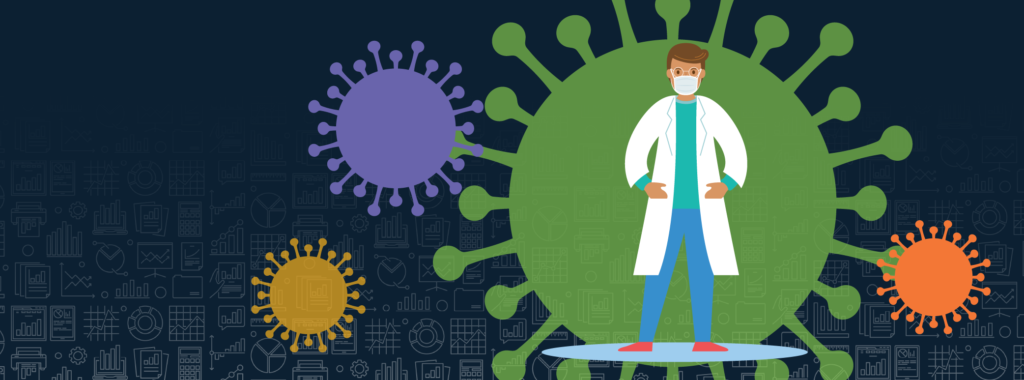
Healthcare providers on the front lines of the coronavirus pandemic continue to be overwhelmed by the increase of cases worldwide. Physicians, nurses and other direct providers are overworked, tired and mentally exhausted from non-stop diagnosis and treatment during the pandemic. And just as the number of new cases seems to decrease, they rise again.
In the US alone there are more than 10.3 million cases and 241,000 deaths. Worldwide, cases number more than 51.8 million with more than 1.2 million deaths. These numbers, undoubtedly, will continue to grow in the coming months. “By June 2020, the COVID-19 pandemic had caused hundreds of thousands of deaths around the world, triggered the largest quarterly contraction of global GDP ever recorded, and left hundreds of millions of people without jobs,” according to research published by the McKinsey Global Institute.
Physicians, nurses and other healthcare providers are not immune from the coronavirus. From its deadly effect or the mental health impact of dealing with the pandemic each day. To date, more than 922 healthcare works in the US likely have died following contact with patients. “America’s health care workers are dying. In some states, medical personnel account for as many as 20% of known coronavirus cases. They tend to patients in hospitals, treating them, serving them food and cleaning their rooms,” according to KHN and The Guardian.
Overall healthcare providers, like those of us in society in general, are extremely stressed by the coronavirus pandemic. A study published in Psychiatry Research found “(o)f all 442 participants, 286 (64.7%) had symptoms of depression, 224 (51.6%) anxiety, and 182 (41.2%) stress. Being female, young, and single, having less work experience, working in frontline were associated with higher scores, whereas having a child was associated with lower scores in each subscale.”
But statistics aren’t necessary to understand that healthcare providers will continue to face substantial anxiety and rising tension for the foreseeable future. “Health-care providers were challenged by working in a totally new context, exhaustion due to heavy workloads and protective gear, the fear of becoming infected and infecting others, feeling powerless to handle patients’ conditions, and managing relationships in this stressful situation,” The Lancet reports.
A change in healthcare delivery
As stress levels in healthcare continue to increase because of the growing number of coronavirus cases, providers are faced not only with physical and mental difficulties but with business challenges, including changes in staffing, patient office visits, furloughs and a decline in elective surgeries. Each has significant revenue ramifications.
One way healthcare providers have worked to maintain patient health and wellness along with their own is by using telemedicine. With today’s technology, telemedicine is highly scalable and effective, allowing healthcare providers to continue treating patients with acute and chronic conditions while protecting the safety of healthcare workers. Many primary care providers now use telemedicine for checkups and to refill prescriptions.
The increased use of telemedicine may be the only positive to come from the pandemic. Part of the collection of patient treatment options, telemedicine had been underused for decades. With the advent of super-fast internet speeds and the ubiquitous webcam, telemedicine now is a viable, reliable and safe way to diagnose and treat patients during the pandemic.
Mental health providers have found telemedicine especially helpful during the pandemic, according to the New York Times. “As the nation gingerly begins to reopen, many providers say that remote therapy is working so well and offers such convenience to their patients that they will continue with it even after the pandemic.”
Direct healthcare providers aren’t the only ones impacted by the pandemic. Their employers—health systems, hospitals, medical groups and others—are feeling the strain. Health systems and hospitals, for example, have experienced two sides of the pandemic.
On one hand, they treat acute coronavirus cases, while attempting to maintain business-as-usual with other types of emergent treatments. On the other, hospitals have had to contend with the cancellation of many elective surgeries to contain the coronavirus and to provide something of a respite for already-exhausted staff. For some surgeons, there was simply no work because of the pandemic.
“When the lockdown happened—or just before, when the number of cases coming to the hospital was dramatically increased, and then the lockdown was announced—I found myself unemployed,” Ara Darzi, a surgeon and the Director of the Institute of Global Health Innovation at Imperial College London, told McKinsey & Company. “Suddenly, everything stops. No one wants to have an operation.”
Back in May, which feels like years in COVID-19 time, the Advisory Board was working to understand how many elective surgeries might be canceled because of the pandemic. “Judgments about what is truly elective vary widely, and so do judgments about what restrictions to impose. Advisory Board modeling and early anecdotal evidence both suggest that around 50% of inpatient surgeries and upwards of 80% of outpatient procedures are subject to provider-directed cancellation or delay.”
Like many other businesses, health systems were forced to counteract the impact of the pandemic on the bottom line, leading to, ironically, layoffs just as coronavirus cases were increasing.
“The financial consequences of such a sudden drop in volume have been immediate and immense,” according to the Advisory Board. “Elective procedures are among hospitals’ most important economic engines. The deferral of so much revenue has put severe pressure on cash flow and cash reserves. In response, systems have begun to furlough staff, but the heavily fixed-cost nature of hospital operations means there are limited options to preserve margins in the short term.”
Indeed, during the first weeks of the pandemic, many elective surgeries were canceled and patients stayed away from the emergency department as hospitals were flooded with coronavirus patients. Five months into the pandemic, people are once again delaying treatments, even those that may save their lives.
Financial resources and data analytics
Diagnosis and treatment of those with the coronavirus remain complex and time-consuming. It has made the provider’s revenue cycle just as complicated as private and public payers change and update the ways coronavirus-related claims are coded and paid.
Telemedicine is one example of a diagnosis and treatment methodology that has come into its because of the pandemic. And while many providers are using telemedicine regularly due to the pandemic, the New England Journal of Medicine says, in general, they have a long way to go compared to other industries. “To continue functioning,” the authors of “Covid-19 and Health Care’s Digital Revolution” write, “private companies and institutions of higher education have made an abrupt transition to remote videoconferencing and other digital solutions, while the health care system is still managing this crisis largely through risky brick-and-mortar visits.”
As medical visits continue to transition to telemedicine, chat and other forms of online appointments, payers will update claims codes and payment models to reflect the “new normal.”
Providers who use data analytics to manage billing for online consultations and appointments, in general, will make the critical move to ensure the organization’s overall revenue cycle integrity during the pandemic. They will come out better on the other side of this monumental healthcare disruption.
Analytics will help providers forecast the pandemic’s impact on:
- cash reserves;
- accounts receivable; and
- and revenue.
Next steps
The goal, if possible, is to bring healthcare back to some semblance of its pre-coronavirus activity. As my colleague, Mary Lou Mangan-Lamb wrote recently: “As providers determine how to get patients to return to facilities for routine disease management and preventive screenings, opportunities are ripe for the application of analytics to triage at the right time to the right setting. Data related to COVID-19 will continue to flow rapidly, but there are possibly more questions than answers now about a return to “normal.” Health systems will have to use data to identify the patients needing immediate care when facilities re-open. The hope is predictive analytics will be used to its highest capacity to help.”
No one knows how the coronavirus will play out in the coming months, although we all hope its effects will lessen significantly with the help of a new vaccine and continued social distancing measures.
In the meantime, healthcare providers should consider bringing together current data analytics solutions along with those created explicitly to monitor and forecast pandemic-related medical services. Indeed, even after the pandemic is better controlled, healthcare providers will need to track medical services, the supply chain, cost and operations details and staffing for many months to come.
Get our take on industry trends
Kick your revenue cycle into a new gear for the new year
Billions of dollars have been invested into electronic health records—and as we’ve said before, they’re great at what they do.…
Read on...The imperative of value-based care: How it’s going and where it’s headed
In the evolving landscape of healthcare, the transition to value-based care stands out as one of the most pivotal initiatives.…
Read on...5 FAQs about data fabric
Data fabric is a term that is growing in recognition throughout technology spaces, but most healthcare leaders still have questions…
Read on...Cheers to 30 more years!
MedeAnalytics recently celebrated 30 years of impact. In the spirit of celebration, our CEO Steve Grieco sat down with Andy…
Read on...


